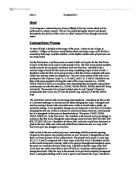c. Psychographic Audience Analysis: values, beliefs, attitudes, behaviours.
4. Issues of concern while speaking to an audience in a pluralistic society:
Suggested answers:
~ be sensitive to audience’s feedback, disposition, responses
~ avoid discriminating against differences in demographic, psychographic or the situational variables
~ try to identify common ground with the audience, do not attempt to change differences that cannot be changed
~ be careful of remarks that might be viewed as stereotypical, prejudiced, discriminatory or racist
Public Speaking and Communication
1. Body language cues indicative of an open, interested or supportive approach:
- frowning and leaning forward with legs open - open & paying attention; frowning is not necessarily a negative sign – it can merely show that someone is thinking about what you are saying.
- sucking the earpiece of a pair of spectacles, nesting chin on their hand - the sucking of items like pens or the earpiece of a pair of spectacles often indicates thoughtfulness; nesting their chin also tends to show contemplation
- occasional nodding and shaking of their head as you proceed - they are obviously paying enough attention to express an opinion; if they shake their head all the time, it could be concluded that they disagree with your message completely
- impassive facial expression, arms folded and legs crossed - a closed signal; either disinterested or hostile to what you are saying
C. clicking a pen whilst scribbling on a notepad - the person is probably bored and distracted
2. Rhetorical or direct question:
- In conclusion, nuclear weapons should be destroyed. Don’t you think so? ~ rhetorical
- I wonder if any of you have used a real gun before. Can you indicate by putting your hand up? ~ direct
- Is there’s one piece of advice that you always keep close to your heart, what would it be? ~ rhetorical
- When was the last time you said ‘I love you’ to your loved ones? Was it yesterday, last week, 3 months ago or 3 years ago? ~ rhetorical
- Could you hear me clearly at the back? Wave your hand if you could. ~ direct
3. Questions to avoid asking the audience:
- embarrassing questions like ‘Have you ever cheated in an exam and were caught red-handed?’
- questions irrelevant, unrelated to the topic
- questions on trivial matters or issues
4. Advantages of using quotation to begin or end a speech:
To begin with a quotation:
- to arouse audience’s interest, focus their attention and set their frame of mind to the central theme, get them to think about the intended message
To end with a quotation:
- to stress the urgency of the topic, reinforce the thesis, sum up or crystallize the central theme, create a deeper impact of the subject matter into the audience’s minds
5. General guidelines in using attention-getting strategies:
- be sincere, enthusiastic; energize the audience with your passion embedded in your message
- strategies must be relevant to the topic, direct audience’s attention to your message or main ideas, not on the strategies itself e.g. jokes, visual aids etc. They should remember your message not your jokes!
- don’t overuse any of the strategies or heavily rely on a few; have varieties but select only those that are appropriate and could be incorporated into the speech seamlessly
- practice makes perfect! Especially stories, jokes, visual aids
Public Speaking and Communication
1. Selecting a topic: students’ own method.
Suggested answers:
i) 5-10; 15-20
ii) Yes – because I have a lot of ideas to choose and I’m sure of what I want to speak; No – too many ideas to choose from/can’t seem to think of anything interesting, difficult to decide what is interesting to the audience
iii) mind mapping, brainstorming, interviewing my friends, listing etc
2. Selecting a topic:
Sample answers:
a) Personal inventory
My experiences: working part-time at McDonalds, snorkelling at Pulau Redang, jungle-trekking at National Park, solo-camping in the jungle, National Service, UTAR Orientation Week
My interests: watching movies, listening to music, clubbing, martial arts, PC gaming
My skills: skate-boarding, street dancing, taekwondo, rock-climbing, drawing cartoon
My beliefs: environmental friendliness, recycling, equality in society, say no to smoking/drinking, charity for the needy
Etc …
b) Clustering
c) Reference research - on the letter‘P’:
- peace
- Pluto
- peanuts
- Pope
- Palm handheld
- Paris
- partying
- PAWS
- Petronas
- Proton Savvy
- Pink
- penguin
- Playboy
- philosophy
- Phantom of the Opera
- Phil Collins
- photography
- piano
- politics
- pot-pourri
- psychology
- puppet
- pyramid
3. Visual brainstorming (or mindmapping) to generate more specific topics and related subtopics.
A sample of visual brainstorming on ‘music’
4. Identifying five possible topics and narrowing the focus of each topic.
5. Giving the topic a title.
Sample answer:
6. Impromptu Speech: My topic.
Sample answer:
I plan to talk about music because I love music, especially classical music. I chose this topic because I would like to share what I know about classical music, specifically Beethoven’s symphonies with my friends and show them that everyone can enjoy classical music. I plan to talk about the themes of Beethoven’s symphonies, which are heroism (Symphony No.3), fate & destiny (symphony No.5) and the beauty of nature (Symphony No.6). At the end of my speech, I hope that my friends will know more about Beethoven’s music, discover the beauty of classical music and develop their interest in this kind of music.








